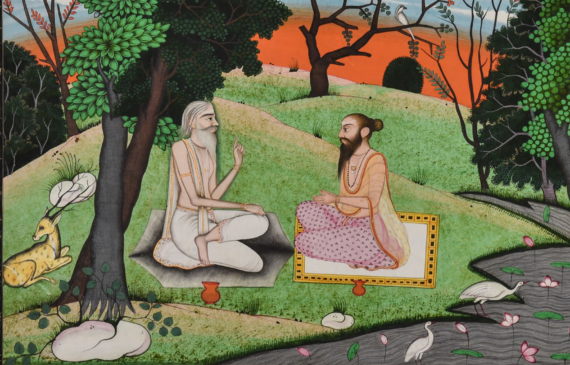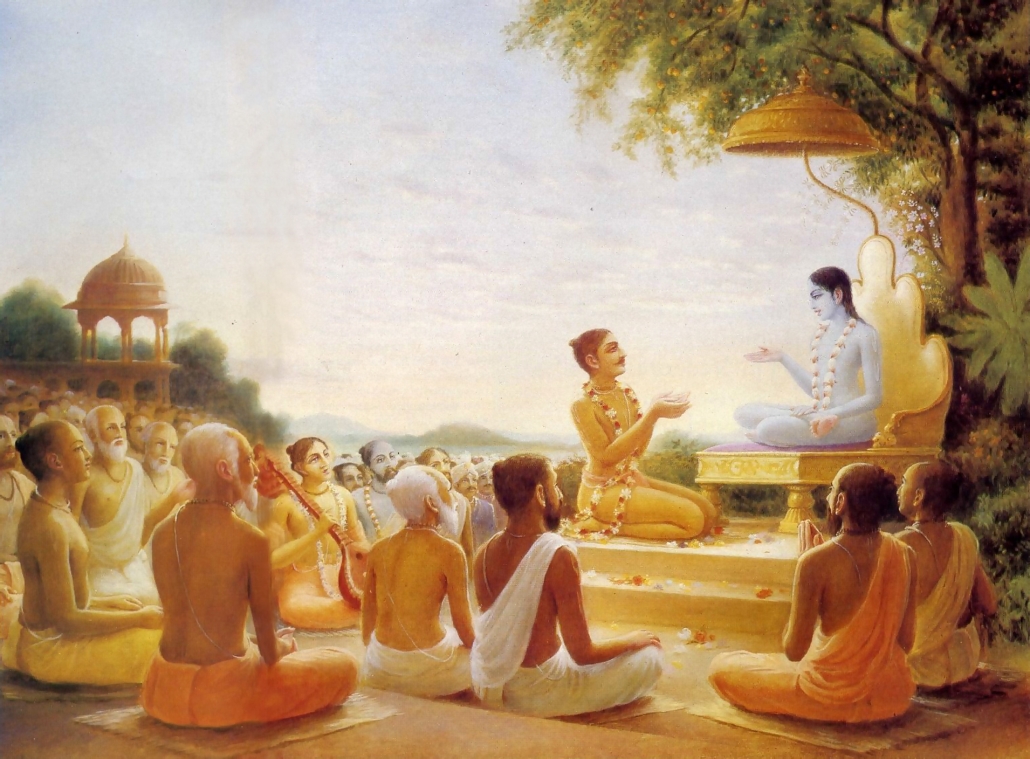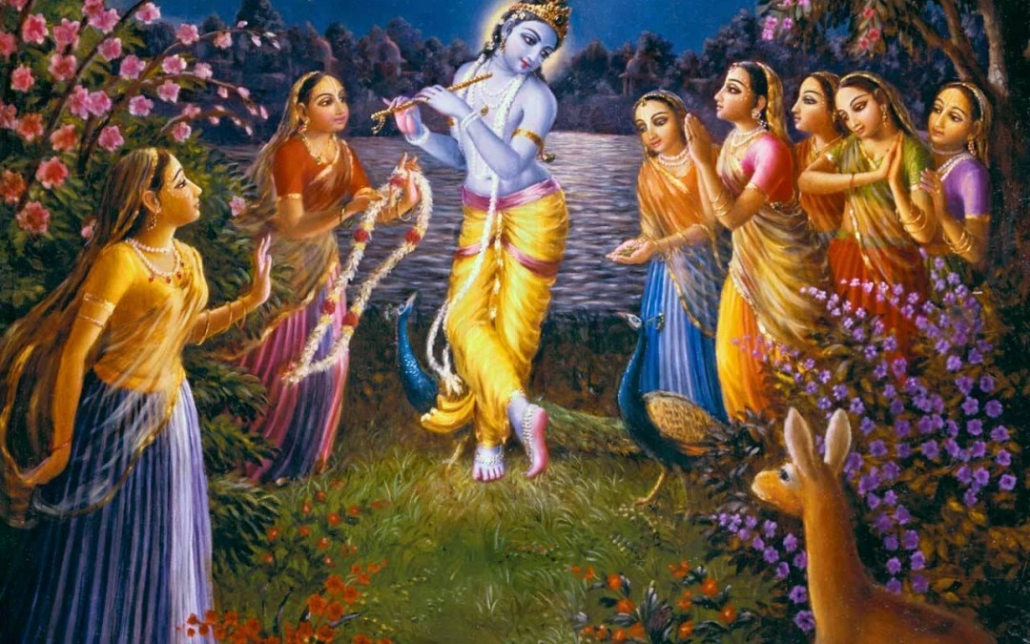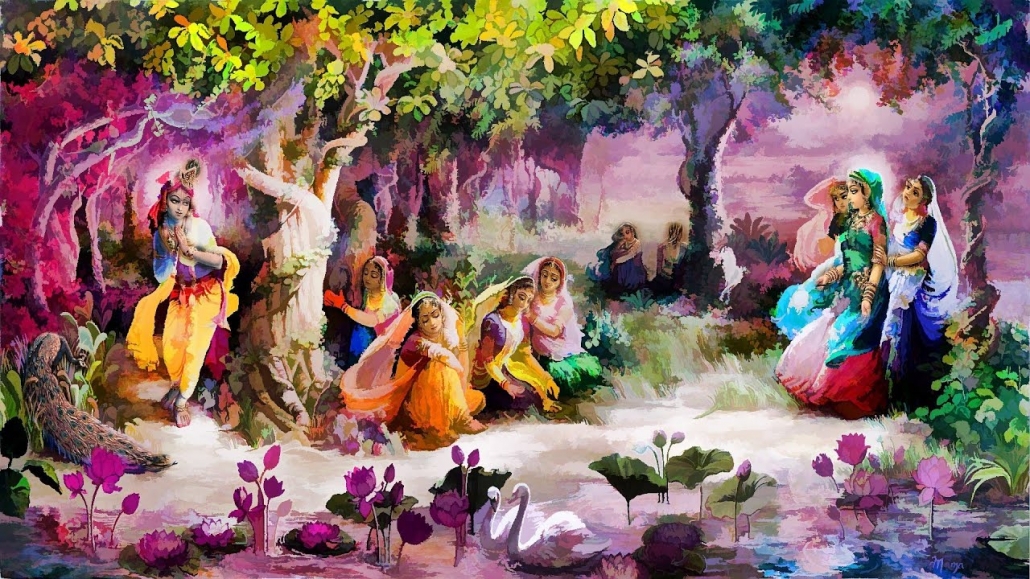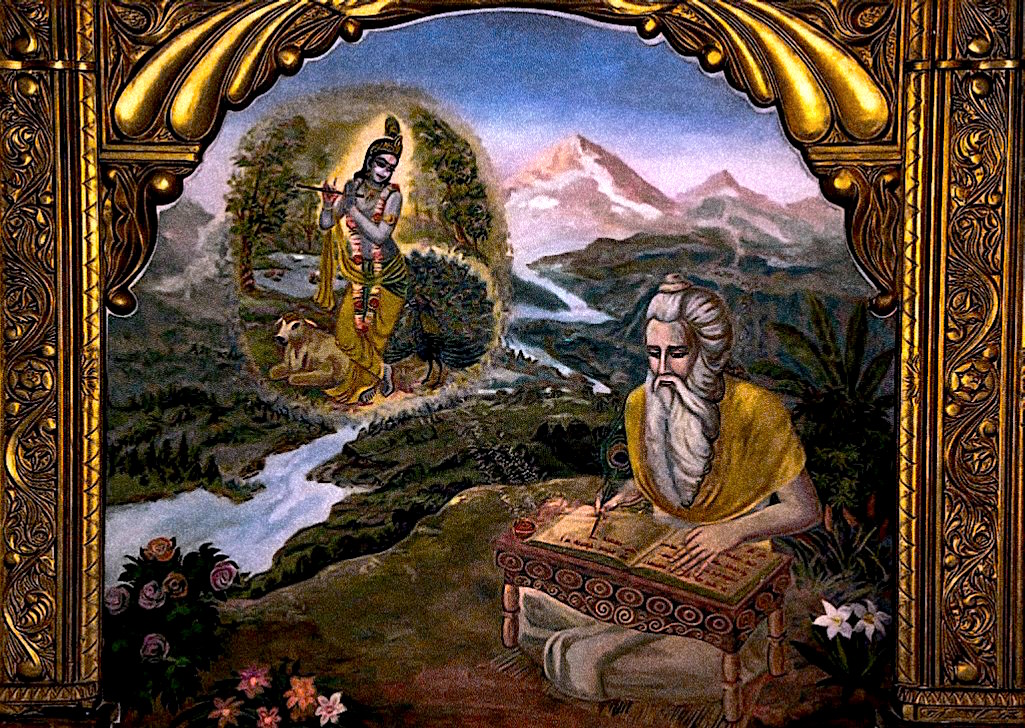Mahanidhi Madan Gopal Das
Srimad Bhagavatam is called the “king of all spiritual books” (Grantha Raja) for good reason. Within this triguna-free, immaculate and divine spiritual shastra, the amala purana, one will find all the sweet, majestic and beautiful truths about the sadhana and sadhya (daily practice and perfection) of Gaudiya Vaisnavism.
In his most compassionate and wonderful shastra, Sri Chaitanya Caritamrita, Sri Krishna Dasa Kaviraja summarizes all the teachings of the six Goswamis of Vrindavana along with the key Bhagavatam verses which prove and substantiate these beautiful truths, and which the Goswamis themselves quoted in their own shastras. The same Bhagavatam verse is sometimes quoted once or twice or even four times within the Sri Chaitanya Caritamrita to highlight its importance for all devotees of Sri Chaitanya Mahaprabhu and Radha-Govinda Yugala.
With the grace of Sri Advaita Prabhu, Sri Guru and the Vaisnavas, we will quote some of these important Srimad Bhagavatam verses from the Sri Chaitanya Caritamrita to present the beautiful truths of Gaudiya Vaisnavism regarding Sri Krishna, Sri Radha, Bhakti Sadhana, Sri Harinama, Krishna Prema, Sri Guru and the Vaisnavas.
I. * THE BEAUTIFUL TRUTH OF SRI GURU
We will begin by describing the basis, beginning point, and the fundamental truths of Krishna bhakti regarding the identity, position and relationship of the sadhaka (the jivatma) with Bhagavan Sri Krishna which is called sambandha tattva.
Sambandha-tattva means the absolute truth regarding the mutual relationship between the Sri Krishna, the jiva and maya, the external material energy. Sambandha means the relationship, bonding and exchanges that culminate in ultimate love, Krishna prema. Included within the category of sambandha-tattva are the beautiful truths i.e. tattvas of Guru, Vaisnava, Bhagavat (SB), Sri Krishna, Gaura, Nityananda, Shakti, and Jiva.
Why does Sri Rupa Gosvami say bhakti bhajana proper begins with surrender to the spiritual master, adau guru pada ashraya? (Bhakti Rasamrita Sindhu 1.2.74) Why, because the benevolent master is the essential contact, connecting point and eternal link between me and God, Bhagavan and the jiva. The beautiful truth about Sri Guru is the substratum of all other spiritual truths.
Thus we now present some of the key Srimad Bhagavatam verses illuminating the truth of Sri Guru. It is suggested that all sincere sadhakas learn and reflect upon these verses. By doing so one will deepen his/her faith, devotional taste and realization, and also increase one’s enthusiasm to serve Sri Krishna and Sri Guru more and more.
1. Sri Guru is One with Sri Krishna
ācāryaṁ māṁ vijānīyān nāvamanyeta karhicit
na martya-buddhyāsūyeta sarva-deva-mayo guruḥ
Srimad Bhagavatam 11.17.27
Bhagavan Sri Krishna said, “O Uddhava! You should know the ācārya, Śrī Gurudeva, to be My very self. You should never disrespect him in any way, be envious of him, or judge him to be an ordinary man, because within Śrī Guru are all the devatas.”
Tika Srila Prabhupada: “Sri Guru is like a parent. Without the attentive service of his parents a child cannot grow to manhood. Similarly, without the care of Sri Guru one cannot rise to the plane of transcendental service.
“In the Vāyu Purāṇa an ācārya is defined as one who knows the import of all the Vedic literatures, abides by their rules and regulations, and teaches his disciples to act in the same way. Only out of His immense compassion does Bhagavan Sri Krishna reveal Himself as the spiritual master. Therefore in the dealings of an ācārya there are no activities but the transcendental loving service to Sri Krishna.
“The spiritual master is known to be a direct manifestation of Bhagavan Sri Krishna and a genuine representative of Śrī Nityānanda Prabhu. A disciple should always respect Sri Guru as a manifestation of Śrī Kṛṣṇa.”
“Śrīla Raghunātha dāsa Gosvāmī confirms that one should always think of Sri Guru in terms of his intimate relationship with Mukunda Sri Krishna [nikunja yuno rati keli siddhyai...]. Sri Jiva Goswamipada says (Bhakti Sandarbha 213), ‘The disciple should see Sri Guru as one with Bhagavan Sri Krishna in terms of his being very dear Sri Krishna but not identical with Bhagavan all respect.
“In all the ancient bhakti shastras and in the bhajans of Sri Narottama Dasa Thakura and Sri Bhaktivinoda Thakura, Sri Guru is always considered to be either one of the confidential associates of Śrīmatī Rādhārāṇī or a manifested representation of Śrīla Nityānanda Prabhu.” (Chaitanya Caritamrita. 1.1.46 pur.)
2. Accept Sri Guru as Your Life & Soul
bhayaṁ dvitīyābhiniveśataḥ syād, īśād apetasya viparyayo ’smṛtiḥ
tan-māyayāto budha ābhajet taṁ, bhaktyaikayeśaṁ guru-devatātmā
Srimad Bhagavatam 11.2.37, (4x in Caitanya Caritamrita)
“The jivas adverse to Bhagavan Sri Krishna are bewildered and full of fear due to misidentifying with their temporary material bodies because of absorption in Krishna’s maya i.e. the external, illusory energy. Therefore, an intelligent person, after accepting Sri Guru as his master and very self (guru devatātmā), must worship Parameshvara Bhagavan Sri Krishna with one-pointed devotion (aikantiki bhakti).”
Tika Srila Visvanatha Cakravarti: “Krishna bhaktas should not fear bondage in saṁsāra because as soon as one starts bhakti bhajana fear is naturally destroyed. Non-devotees, however, will always be bound by fear and samsara because they falsely identify with their material body and senses.
“Sri Brahmaji says, ’O Krishna! Until people become Your devotees, their material attachments and desires are thieves, their homes are prisons, and their affectionate feelings for their family members are iron chains binding their feet.’ (Srimad Bhagavatam 10.14.36)
“That fear of saṁsāra takes two forms: foolishness and forgetfulness. Foolishness means thinking, “I am this body, bas!” And forgetfulness means not knowing or forgetting one is actually an eternal spiritual being, a jivatma.
“The forgetful ones never ask questions concerning their past or future. They never ask, “Who am I? What should I do? What was I before? What will I be after?” The word ataḥ in line one of this verse means that the wise, after gaining intelligence by the mercy of Gurudeva’s lotus feet, should fully worship (bhajet) Bhagavan Sri Krishna with pure bhakti devoid of other desires and devoid of karma or jñāna. Such a wise soul considers Sri Guru to be as dear as Bhagavan Sri Krishna and as dear as the self. “
3. Sri Krishna Appears Before Our Eyes as Sri Guru and Internally as the Paramatma, Antaryami
naivopayanty apacitiṁ kavayas taveśa, brahmāyuṣāpi kṛtam ṛddha-mudaḥ smarantaḥ
yo ’ntar bahis tanu-bhṛtām aśubhaṁ vidhunvann, ācārya-caittya-vapuṣā sva-gatiṁ vyanakti
Srimad Bhagavatam 11.29.6
“Sri Uddhava said, ‘O Parameshvara Sri Krishna! Intelligent devotees attain the pinnacle of bliss whenever they remember all that You have done for them. And even if they had the lifespan of Sri Brahmaji, they could never pay off their debt to You. For You so kindly appear in two features—externally as the acharya Sri Guru and internally as Paramātma (Antaryami)—to destroy their misfortune and show the way to You [Krishna prema].”
Tika Srila Visvanatha Cakravarti: “To this Sri Krishna replies, ‘O Uddhavaji! Because I give all benedictions only to persons who worship Me, such bestowals are not unconditional. Rather they are conditional.’
Uddhava: ‘Hey Bhagavan! This is not so. Whatever worship the devotees perform is actually given by You alone. You are the supreme unconditional giver of benedictions. People can never repay their debt even by serving You for thousands of Brahmā’s lifetimes.
‘When Your devotees remember what You have done for them, their bliss increases. What have you done? You appear externally as the mantra-guru and śikṣā-guru to give them mantra diksha and bhakti shiksha. And You appear internally as Paramātmā to give them the intelligence to attain You, dadāmi buddhi-yogaṁ taṁ yena mām upayānti te. (Bhagavad Gita 10.10).
‘And it is You alone that make Your devotees worship You, and You reveal to them the goal of becoming Your eternal loving associate.’”
4. Qualifications of Real Disciple
amāny amatsaro dakṣo nirmamo dṛḍha-sauhṛdaḥ
asatvaro ’rtha-jijñāsur anasūyur amogha-vāk
Srimad Bhagavatam 11.10.6
“A disciple of the Guru should be free from false pride and never consider him/herself to be the doer. The disciple should be active, expert, never lazy, and free from the false conception of “I and mine.” The disciple should have feelings of loving friendship toward Sri Guru, and be patient in attaining the goal, without becoming overwhelmed by material passion. The disciple must eagerly inquire about the Absolute Truth, be free from envy, and always avoid useless talk.”
Tika Srila Visvanatha Cakravarti: “The true disciple should be devoid of possessiveness (nimamaḥ), and have firm affection Sri Guru and Sri Krishna. The disciple should not be hasty [madly passionate] in attaining his desired goal (asatvaraḥ) of Krishna prema.”
Sri Guru tattva ki jai! Srimad Bhagavatam ki jai! Jaya Jaya Sri Radhe!
Please also see other articles from “Beautiful Truths of Bhagavata” 002, 003, 004, 005, 006.

